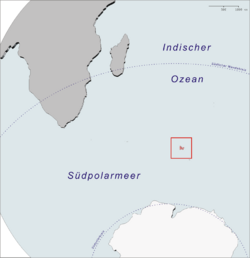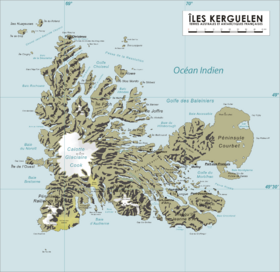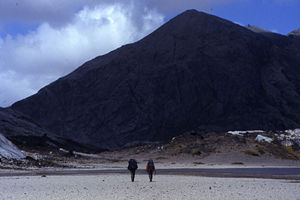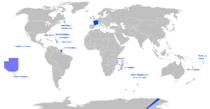Kerguelen Islands
| Kerguelen Islands
Archipel des Kerguelen
|
||||||
|---|---|---|---|---|---|---|
|
||||||
 |
||||||
 Map of Kerguelen Island
|
||||||
| Capital | Paris, France |
|||||
| Official languages | French | |||||
| Government | ||||||
| - | President | Nicolas Sarkozy | ||||
| - | Administrator | Eric Pilloton | ||||
| French overseas territory | District of the French Southern and Antarctic Lands | |||||
| - | Discovery | February 1772 | ||||
| Area | ||||||
| - | Total | 7,215 km2 2,786 sq mi |
||||
| Population | ||||||
| - | census | about 70 (winter); 110 (summer) | ||||
| Currency | the euro (EUR) |
|||||
| Time zone | UTC+5 | |||||
| Internet TLD | .tf | |||||
| Calling code | 262 | |||||
The Kerguelen Islands (pronounced /ˈkɝːɡɨlɨn/; in French commonly Îles Kerguelen or Archipel de Kerguelen but officially Archipel des Kerguelen or Archipel Kerguelen, French pronunciation: [kɛʁɡəlɑ̃]), also known as Desolation Island, is a group of islands in the southern Indian Ocean. It is a territory of France.
The Kerguelen Islands are located at , which is antipodal to the area where Alberta, Saskatchewan, and Montana meet in North America. The main island, Grande Terre, is 6,675 km² and it is surrounded by another 300 smaller islands and islets, forming an archipelago of 7,215 km². The climate is raw and chilly but not severely cold throughout the year - much like that of the outer Aleutian Islands of Alaska - with frequent high winds, and while the surrounding seas are generally rough, they remain ice-free year-round.
Contents |
History

The islands, along with Adélie Land, the Crozet Islands, and the Amsterdam and Saint Paul Islands are part of the French Southern and Antarctic Lands and are administered as a separate district.
They were discovered by the French navigator Yves-Joseph de Kerguelen de Trémarec in February 1772.
Soon after their discovery, this archipelago was regularly visited by whalers and sealers (mostly British, American, and Norwegian) who hunted the resident populations of whales and seals to the point of near extinction, including fur seals in the 18th century and elephant seals in the 19th century. Since the end of the whaling and sealing era, most of the islands' species have been able to re-establish themselves.
In the past, a number of expeditions briefly visited the islands, including that of Captain James Cook in 1776. The German auxiliary cruiser Atlantis called at Kerguelen during December 1940. During their stay the crew performed maintenance and replenished their water supplies. This ship's first fatality of the war occurred when a sailor fell while painting the funnel. He is buried in what is sometimes referred to as "the most southerly German grave" of the Second World War.
Kerguelen has been used by a small number of science teams since 1949, with a population of fifty to one hundred frequently present. There is also a French satellite tracking station. The main island is the home of a well-established feral cat population, descended from ships' cats. They survive on sea birds and the feral rabbits that were introduced to the islands. There is also a population of feral sheep from when sheep-raising was attempted here. The islands are also known for the indigenous, edible Kerguelen cabbage, a good source of vitamin C to ancient mariners. It was frequently served with corned beef.
The main base, the so-called "capital" of the islands, is located at the eastern end of the Gulf of Morbihan on Grande Terre island at , and it is known as Port-aux-Français. Facilities there include scientific-research buildings, a satellite tracking station, dormitories, a hospital, a library, a gymnasium, a pub, and the chapel of Notre-Dame des Vents.
In 2000, one of the men wintering-over was killed in a hunting accident on Ile Haute, an event written about by a British journalist, Matthew Parris, during a stay while writing a news column on the islands. [1]
Grande Terre

The main island of this archipelago is called La Grande Terre. It measures 150 km east to west and 120 km north to south. The highest point is the Galliéni Massif (Pic du Grand-Ross), which lies along the southern coast of the island and has an elevation of 1850 meters. The Cook Glacier, which covers approximately 550 square km, lies on the west-central part of the island. Grande Terre has numerous bays, inlets, fjords, and coves, as well as several peninsulas and promontories. The most important ones are listed below and indicated on the map by numbers:
- Courbet Peninsula
- Péninsule Rallier du Baty
- Péninsule Gallieni
- Péninsule Loranchet
- Presqu'île Jeanne d'Arc
- Presqu'île Ronarc'h
- Presqu'île de la Société de Géographie
- Presqu'île Joffre
- Presqu'île du Prince de Galles
- Presqu'île du Gauss
- Presqu'île Bouquet de la Grye
- Presqu'île d'Entrecasteaux
- Presqu'île du Bougainville
- Presqu'île Hoche
Notable localities
There are also a number of notable localities, all on Grande Terre (see also the main map):
- Anse Betsy [Betsy Cove] (a former geomagnetic station at ), on Baie Accessible [Accessible Bay], on the north coast of the Courbet Peninsula. On this site an astronomical and geomagnetic observatory was erected on 26 October 1874 by a German research expedition led by Georg Gustav Freiherr von Schleinitz. The primary goal of this station was the 1874 observation of the transit of Venus.
- Armor (Base Armor), established in 1983 forty kilometers west of Port-aux-Français at the bottom of Morbihan Gulf, for the acclimatization of salmon to the Kerguelen islands [1]
- Baie de l'Observatoire [Observatory Bay] (a former geomagnetic observation station at ), just west of Port-Aux-Français, on the eastern fringe of the Central Plateau, along the northern shore of the Golfe du Morbihan.
For the 1874 transit of Venus, George Biddell Airy at the Royal Observatory of the U.K. organized and equipped five expeditions to different parts of the world. Three of these were sent to the Kerguelen Islands. The Reverend Stephen Joseph Perry led the British expeditions to the Kerguelen Islands. He set up his main observation station at Observatory Bay and two auxiliary stations, one at Thumb Peak [49°31'11".8 S, 70°10'18".1 E] led by Sommerville Goodridge, and the second at Supply Bay [49°30'47".3 S, 69 °46'13".2 E] led by Cyril Corbet. Observatory Bay was also used by the German Antarctic Expedition led by Erich Dagobert von Drygalski in 1902-03. In January 2007, an archaeological excavation of this site was carried out.
- Cabane Port-Raymond (scientific camp at ), at the head of a fjord cutting into the Courbet Peninsula from the south.
- Cap Ratmanoff (geomagnetic station at ), the eastmost point of the Kerguelens.
- La Montjoie (scientific camp at ), on the south shore of Baie Rocheuse, along the northwestern coast of the archipelago.
- Molloy (Pointe Molloy), a former observatory ten kilometers west of the present-day Port-Aux-Français, along the south coast of the Courbet Peninsula, or northern shore of the Golfe du Morbihan (Kerguelen), at . An American expedition led by G. P. Ryan erected a station at this site on 7 September 1874. That station was also established to observe the 1874 transit of Venus.
- Port Bizet (seismographic station at ), on the northeastern coast of Île Longue. This also serves as the principal sheep farm for the island's resident flock of Bizet sheep.
- Port Christmas (a former geomagnetic station at ), on Baie de l'Oiseau, in the extreme northwest of the Loranchet Peninsula. This place was so named by Captain James Cook, who re-discovered the islands and who anchored there on Christmas Day, 1776. This is also the place where Captain Cook coined the name "Desolation Islands" in reference to what he saw as a sterile landscape.
- Port Couvreux (a former whaling station, experimental sheep farm, and geomagnetic station, at ), on Baie du Hillsborough, on the southeast coast of Presqu'île Bouquet de la Grye. Starting in 1912, sheep were raise here to create an economic base for future settlement, however, the attempt failed and the last inhabitants had to be evacuated, and the station abandoned, in 1931. The huts remain as well as a graveyard with five anonymous graves. These are those of the settlers who were unable to survive in the harsh environment.
- Port Curieuse (a harbor on the west coast across Île de l'Ouest ). The site was named after the ship La Curieuse, which was used by Raymond Rallier du Baty on his second visit to the islands (1913-14).
- Port Douzième (literally Twelfth Port, a hut and former geomagnetic station at ), on the north coast of Presqu'île Ronarch, southern shore of the Golfe du Morbihan.
- Port Jeanne d'Arc (a former whaling station founded by a Norwegian whaling company in 1908, and a former geomagnetic station at ), in the northwestern corner of Presqu'île Jeanne d'Arc, looking across the Buenos Aires passage to Île Longue (4 km northeast). The derelict settlement consists of four residential buildings with wooden walls and tin roofs, and a barn. One of the buildings was restored in 1977, and another in 2007.
Since 1963, just east of Port-aux-Français is a launching site for French sounding rockets (mainly Arcas, Dragons, and Eridans).
The islands
The following list the most important adjacent islands:
- Île Foch in the north of the archipelago, at , is the largest satellite island with an area of 206.20 km². Its highest point, at 687 m, is called La Pyramide Mexicaine.
- Île Howe which lies less than one kilometre off the northern coast of Ile Foch is, at ~54.00 km2, the second most important offlier in the Kerguelens
- Île Saint-Lanne Gramont, is to the west of Île Foch in the Golfe Choiseul. It has an area of 45.80 km². Its highest point reaches 480 m ().
- Île du Port, also in the north in the Golfe des Baleiniers at , is the third largest satellite island with an area of 43.00 km², near its centre it reaches an altitude of 340 m.
- Île de l'Ouest (west coast, about 40.00 km², )
- Île Longue (southeast, about 40.00 km² )
- Îles Nuageuses (northwest, including île de Croÿ, île du Roland, îles Ternay, îles d'Après, )
- Île de Castries ()
- Îles Leygues (north, including île de Castries, île Dauphine, )
- Île Violette ()
- Île aux Rennes [also known as Reindeer Island or Australia Island] (western part of the Golfe du Morbihan, area 36.70 km², altitude 199 m, )
- Île Haute (western part of the Golfe du Morbihan, altitude 321 m, )
- Île Mayès ()
Economy
Principal activities on the Kerguelen Islands focus on scientific research - mostly earth sciences and biology.
The former sounding rocket range to the east of Port-aux-Français is currently the site of a SuperDARN radar.
Since 1992, the French Centre National d'Études Spatiales (CNES) has operated a satellite and rocket tracking station which is located four kilometers east of Port-aux-Français. There was a need for a tracking station in the Southern Hemisphere, and the French government required that it be located on French territory, rather than in a populated, foreign place like Australia or New Zealand.
Agricultural activities are limited to raising sheep (approximately 3500 Bizet sheep - an endangered species in metropolitan France) on Longue Island for consumption by the occupants of the base, as well as small quantities of vegetables in a greenhouse within the immediate vicinity of the main French base. There are also feral rabbits and sheep that can be hunted, and wild birds.
There are also some fishing boats and vessels, owned by fishermen on Réunion Island - a department of France - who are licensed to fish within the archipelago's Exclusive Economic Zone.
Geology

The Kerguelen islands form an emerged part of the submerged Kerguelen-Heard tectonic plate, which has a surface area nearing 2.2 million square kilometres. [2]
The major part of the volcanic formations visible on the islands are characteristic of an effusive volcanism, which caused a trap rock formation to start emerging above the level of the ocean 35 million years ago. The accumulation is of a considerable amount; basalt flows, each with a thickness of three to ten meters, stack on top of each other, sometimes up to a depth of 1,200 metres. This form of volcanism creates a monumental relief shaped as stairs of pyramids.
Other forms of volcanism are present locally, such as the strombolic volcano Mont Ross, and the volcano-plutonic complex on the Rallier du Baty peninsula. Various veins and extrusions of lava such as trachytes, trachy-phonolites and phonolites are common all over the islands.
No eruptive activity has been recorded in historic times, but some fumaroles are still active in the South-West of the Grande-Terre island.
A few lignite strata, trapped in basalt flows, reveal fossilised Araucariaceae fragments, dated at about 14 million years of age.
Glaciation caused the depression and tipping phenomena which created the gulfs at the north and east of the archipelago. Erosion caused by the glacial and fluvial activity carved out the valleys and fjords; erosion also created conglomerate detrital complexes, and the plain of the Courbet Peninsula.
The islands are part of a submerged microcontinent called the Kerguelen sub-continent.[3] The microcontinent existed for three periods between 100 million years ago and 20 million years ago. The so-called Kerguelen sub-continent may have had tropical flora and fauna about 50 million years ago. The Kerguelen sub-continent finally sank 20 million years ago and is now one to two kilometers below sea level. Kerguelen's sedimentary rocks are similar to ones found in Australia and India, indicating they were all once connected. Scientists hope that studying the Kerguelen sub-continent will help them discover how Australia, India, and Antarctica broke apart.[4]
Flora and fauna
- See main article: Flora and fauna of the Kerguelen Islands.
Kerguelen Islands in popular culture
- In the seafaring novel Desolation Island, one of the Aubrey–Maturin series by Patrick O'Brian, the crew repair their disabled ship on an island that strongly resembles Kerguelen, although a later book in the series asserts that it this was a different Desolation Island, located somewhere "further south and east," (probably Heard Island, though this island wasn't confirmed to exist until the 1850s.)
- In The Narrative of Arthur Gordon Pym of Nantucket, Edgar Allan Poe's only complete novel, the crew of the Jane Guy alights at Kerguelen Island before eventually pushing on towards the South Pole.
- In Biggles' Second Case by W. E. Johns, Biggles searches for Nazi gold just after World War II on and around Kerguelen.
- Warbots (no. 5) Operation High Dragon involves a secret Chinese military base located on Kerguelen Island. ISBN 1-55817-159-2
- In Gundam - The 08th MS Team, the Zeon Zanzibar-class cruiser used to evacuate Ginias Sakhalin's forces from their base is named Kerguelen.
- In the Danish graphic novel Mikkeline på skattejagt (Mikkeline's Treasure Hunt) by draftsman and cartoonist Claus Deleuran, Desolation Island plays a major role in the plot. In the humorous story the active volcano Mont Ross serves as a back entrance to hell as described in The Divine Comedy by Dante Alighieri. ISBN 87-7378-244-0
- The novel The Lost Flying Boat by Alan Sillitoe is situated around Kerguelen, though the islands' geography are not accurately described.
- The Swedish comic James Hund by Jonas Darnell & Patrik Norrmann has set at least one episode on Kerguelen, where a satanic Nazi conspiracy against the world's leaders has its seat.
- The first chapter of Jules Verne's Le Sphinx des glaces (An Antarctic Mystery) is entitled "Chapitre 1 - Les Îles Kerguelen" ("Chapter 1 - The Kerguelen Islands").
- In Patrick Robinson's Kilo Class (ISBN 0-06-109685-7), naval confrontations arise in the Kerguelen Islands between the Americans, the Chinese, and the Taiwanese.
- In the novel An Inexplicable Story by Josef Skvorecky, the chapter "A Letter from Herr Rudolf Ceeh" is a report by a German submariner about his stay on the Kerguelen Islands.
- The science fiction novel Rocannon's World by Ursula LeGuin mentions a planet called "New South Georgia", whose chief city is "Kerguelen".
- In the G. A. Henty novel The Young Midshipman, Chapter XVI (Old Joe's Yarn), Joe relates being shipwrecked on the Kerguelens and spending a winter surviving on Kerguelen cabbage, melted snow and seal meat before hiking to Betsy Cove, off of Hillborough Bay and being rescued by passing whalers.
See also
- French overseas departments and territories
- Administrative divisions of France
- Islands controlled by France in the Indian and Pacific oceans
- Sub-antarctic islands
References
External links
- Official site (In French)
- Official site (In French)
- Cartography of the Kerguelen, including a toponymy index (In French)
- Kerguelen Archipelago
- Southern & Antarctic Territories
- Columns about Kerguelen from The Times
- Personal site with many pictures
- Rocket launches on the Kerguelen Islands
- South Atlantic & Subantarctic Islands site, Kerguelen Archipelago page
|
||||||||||||||||||||||||||||||||||||||||
|
|||||||||||||||||||||||||||||||||||||


